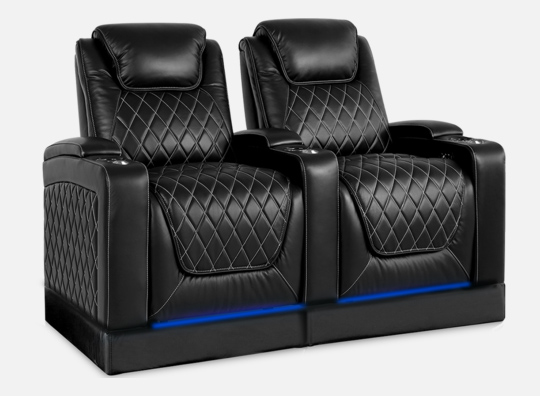A home theater riser platform is exactly what it sounds like: a built platform for the back rows of home theater recliners. Why do some people put home theatre risers in their media room? Well, viewing angles, of course! You’ve just spent all this time and money on your DIY home theater – now is not the time to skimp on the setup of your home theater’s furniture. If your setup is going to include multiple rows of home theater seats or recliners, you have to consider the viewing angle of each row separately. And that means you need home theater riser platforms. Because, honestly, how much fun is watching a movie while constantly trying to look around the back of someone’s head? Or having to crane your neck at a screen that’s too high for comfortable viewing.

Say you’re planning on using rows of 4 seat home theater seating. Have you taken into account during your measurements how much walking room will be left on each side of the row? If you’re combining a home theater sectional seating area behind a couple 2 seat home theater recliners – how much height will the riser platform need to accommodate the home theater sectional and easy walking paths around and behind the sectional? It’s not as easy as getting the dimensions of the home theater chairs and eyeballing what depths and heights might work; there’s actually a lot more to consider. So let’s get into the details of designing the best home theater risers for your unique space.
What do I Need to Consider When Deciding on Home Theater Risers?
Spatial Considerations for Rows of Home Theater Seating
Say you want 6 seats in your home theater. You can get a row of curved home theater seating to try and make viewing angles ideal for people on either end. But you need a pretty large room for this to work: it’d have to be wide enough for the row and deep enough for optimal viewing distance. Tricky, right? But if you install a home theater riser platform, everything is simplified. You can use a smaller room and still get 6 home theater recliners in there because you’re taking advantage of vertical space. Not to mention that no one will be made to view the movie from an oblique angle.
Figuring the Ideal Height of the Riser Platform
There are a few variables at work here that are all important, because one affects the other, which affects the next, and so on. First, get the measurements of the home theater chairs you chose so you know the height. Then add an estimate height for if people’s heads will go above it. Okay, now we get to the math:
- When installing or marking out the first row of home theater seating, sit in the chair and look at the projector. Is the center of the screen slightly above eye line, but comfortably so? Find that sweet spot and adjust the projector screen until it’s just right.
- Calculate that viewing angle. You can do this with the help of a friend, a cell phone camera, and a little sine-cosine-tangent work.
- Now measure the distance of the second row from the projector screen. How much more height does the second row need so that their viewing angle is the same as the first row’s?
This method works for home theater seating that’s arranged into 2 rows. Usually, this means the projector screen sits somewhere between 2 and 3 feet off the ground, and the home theater riser platform for the second row is usually at least 1 foot above the first row.
What if I Want Three or More Rows of Home Theater Seats?
Now, if you have 3 or more rows of home theater seats in your media room, viewing angles have to shift, and so does the position of the projector screen. The necessary amount of height you need for the home theater riser platforms is going to be impossible in a typical basement home theater, so this many rows isn’t an option for low ceilings and basements, no matter how big the room is.
The best home theater seating manufacturers suggest that if you have 3+ rows of theater seating, the projector screen should be raised to between 3 and 4 feet off the ground. Home theater riser platforms for more than 2 rows is ideal for long and narrow rooms. The first row can get the distance they need from the projector screen, and the back row still gets the height they need to view the movie comfortably as well.
Long story short, the addition of home theater risers to your media room design is an architectural and structural choice. Therefore, it should be considered and measured in just as much detail as you’d consider when measuring something like a countertop cut through an expensive granite slab. Consider all the factors before you shop for your home theater recliners or sofas; that way you’ll know what you’re looking for and will know how to customize it in our 3D build module. Give us a call. We’re happy to help. 888-533-9991
